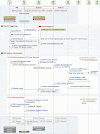LTE - ARCHITECTURE
* LTE refers to the Evolved UMTS Radio Access Network (E-UTRAN), whereas System Architecture Evolution (SAE) refers to the
Evolved Packet Core (EPC). Figure 1 illustrates this division between radio access and core networks
* LTE uses a flat architecture without a Radio Network Controller (RNC), nor Base Station Controller (BSC)
* The LTE equivalent of a UMTS Node B is an 'evolved' Node-B. An eNode B is the Base Transceiver Station (BTS) for
LTE. Radio resource management is completed by the eNode B
* eNode B are connected to the Evolved Packet Core (EPC) using a Mobility Management Entity (MME) for control plane signalling,and a Serving Gateway for user plane data
* The Serving Gateway is connected to a Packet Data Network (PDN) Gateway for connectivity to external networks including the public internet
* Figure 2 illustrates a radio access network which includes macro, micro, pico and femto BTS, as well as relays and repeaters. This type
of radio access network is known as a heterogeneous network because it includes a range of different BTS types
* The most common BTS type is the macro BTS, which 3GPP categorizes as a 'wide area BTS'. 3GPP categorizes pi co BTS as 'local
area BTS' and femto BTS as 'home BTS'. 3GPP does not specify a separate power class for micro BTS but a wide area BTS with
reduced transmit power could be designed and used as a micro BTS. 3GPP also specifies separate requirements for repeaters and relays
* Macro BTS are characterized by having their antenna above roof-top level so their coverage area is relatively large. Their transmit power is typically 20, 40 or 60 Watts, and they normally have more than a single sector
* Micro BTS are characterized by having their antenna below roof-top level so their coverage tends to be limited by neighbouring buildings. Their transmit power is typically 5 or 10 W,, and they often have only a single sector
* Pico BTS are designed to provide coverage and capacity across small areas. Their transmit power does not exceed 0.25 W so their antenna needs to be close to the source of traffic
* Femto BTS are intended for use at home, or in small offices. Their transmit power does not exceed 0.1 W so they need to be used in areas where coverage from other BTS types is relatively weak, e.g. indoors. In contrast to other BTS types, the location ofFemto BTS is not usually controlled by the network operator. End-users are free to place their Femto BTS wherever they like. The network architecture for Femto BTS also differs from other BTS types. Femto BTS are connected to the Evolved Packet Core using a Home eNode B Gateway (also known as a Femto Gateway). The connection between the Femto BTS and Femto Gateway typically uses a
home broadband connection, e.g. ADSL
* Repeaters can be used to extend the coverage of an existing BTS. They re-transmit the uplink and downlink signals without having to decode any of the content. Repeaters have one antenna directed towards the donor cell, and a second antenna directed towards the target coverage area. The target coverage area could be an indoor location so the second antenna could be indoors
* Relays also rely upon an RF connection to a donor cell, but Relays differ from Repeaters because Relays have their own cells and their own protocol stack, i.e. a Relay is similar to a normal BTS but without a fixed transport connection. Relays decode signals and make radio resource management decisions
The various BTS types typically share the same channel bandwidth, so heterogeneous networks generate challenges in terms of cochannel interference and RF planning to achieve the intended coverage from each site. Traffic management can also be challenging when Closed Subscriber Groups (CSG) are used to ensure that only authorised subscribers can use certain BTS, e.g. only the family owning a Femto BTS can use that BTS. That BTS then appears as a source of interference to other subscribers






0 Comments